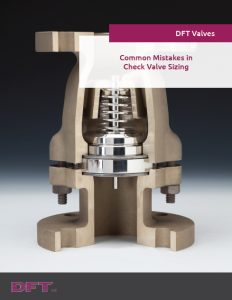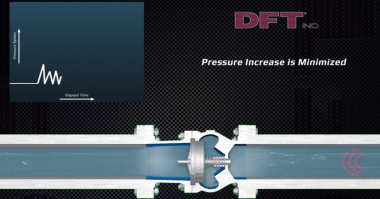At the most basic level, check valves are any valve that allows for fluid to flow in one direction and prevents backflow in the other. They are self-automated, using the pressure of the fluid to open and close rather than an operator. Swing valves and axial flow silent valves are the two most popular types of check valves. So, what is the difference between swing check valves and axial flow silent check valves? Specifically, in terms of operation and return on investment (ROI)?
Swing Check Valves
A fairly basic type of valve, swing check valves are butterfly-style, meaning the disc — the part that blocks the fluid flow — opens and closes on a hinge or trunnion. Although these are ideal for some applications, swing check valves are being steadily phased out due to common recurring problems, such as turbulent flow and water hammer.
Axial Flow Silent Check Valves
Axial flow silent check valves are an updated design on swing check valves. The disc in the valve is held in place by a spring. This centers the movement of the disc, allowing for smoother fluid flow and responsive opening and closing without the sudden movements that cause water hammer.
Watch this video for a more detailed comparison of these two valve types.
Which Offers Better ROI?
Because axial flow silent check valves are more complex to design and manufacture, they usually come with a higher price tag than traditional swing check valves. Many plant managers do not understand how the low cost of ownership and long term benefits of these axial flow silent valves far outweigh the initial higher price. A ROI study with data spanning over 20 years proves this case.
The study, conducted at a utility facility, compared the costs of using swing check valves for 10 years, before a conversion to axial flow silent check valves, and the costs of using DFT® Inc. axial flow silent check valves for 10 years after installation. This study compared valve costs and overhead costs — including shipping, installation costs, and administrative costs — for two valve classes, 150# and 300#.
For the 150# valves, swing check valves cost an average of $1,467.12 each, while axial flow silent check valves cost an average of $4,812.99 each; per valve overhead was $1,000 for both swing and axial flow silent check valves. The swing check valves had to be replaced an average of 4.5 times a year, bringing their use cost to $11,102 annually — more than $111,000 over a decade.
After the conversion to DFT® Inc.’s axial flow silent valves, replacements dropped dramatically, from 4.5 times a year to once every 3.5 years. Despite the higher initial cost of the spring-assisted valves, their superior performance reduced annual maintenance costs to $1,660.85, or just over $16,600 for the decade; that’s an 85% reduction in overall operating cost.
The cost reduction in 300# check valves was even more significant. Before conversion, these valves resulted in $102,750 in costs over 10 years of use; in the 10 years since the installation of DFT® silent check valves, however, the company has not yet had to replace them.
Choosing the Right Axial Flow Silent Check Valve
Despite a higher initial price tag, axial flow silent check valves offer a significantly higher ROI than swing check valves, thanks to their superior performance and reliability. DFT® Inc. manufactures axial flow, spring-assisted, silent check valves. To find out which type is right for your application, view our full catalog of silent, spring-assisted check valves and access DFT CAD files in our online CAD library.
 COMMON MISTAKES IN CHECK VALVE SIZING
COMMON MISTAKES IN CHECK VALVE SIZING
Proper maintenance of check valves can ensure a longer lifetime of use, proper flow and overall efficiency of your fluid handling system. Knowing which check valves can withstand different environmental factors, and how check valve sizing works is a key component in that maintenance. To help you get the most from your check valves, DFT has created a free eBook that includes an overview of the risks of oversizing check valves and the outcomes, a list of check valve sizing issues to be on the lookout for, and how to prevent water hammer and reduce lifetime check valve costs.




Comments